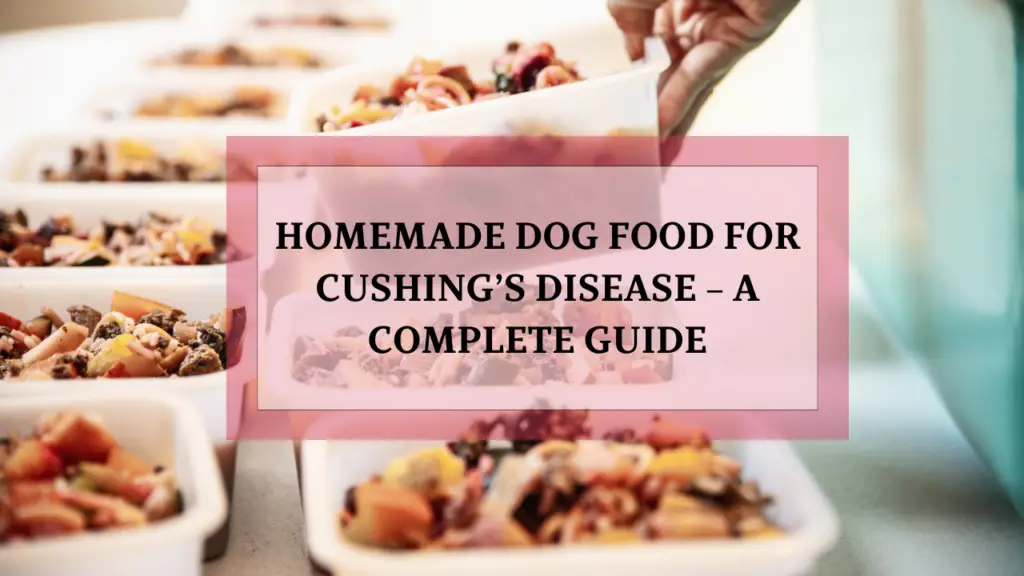Cushing’s disease is a common endocrine disorder in dogs, caused by excessive production of cortisol. While medication and veterinary care are crucial, diet plays a vital role in managing symptoms and improving a dog’s quality of life. Many commercial dog foods contain high levels of carbohydrates, preservatives, and unhealthy fats, which can exacerbate the condition. Switching to homemade dog food for Cushing’s disease allows for better control over ingredients, ensuring an optimal balance of nutrients tailored to your pet’s needs.
This guide will cover everything you need to know about homemade dog food for Cushing’s disease, including nutritional considerations, recipes, feeding guidelines, and additional tips for managing the condition.
Understanding Cushing’s Disease in Dogs
What Is Cushing’s Disease?
Cushing’s disease, or hyperadrenocorticism, occurs when a dog’s adrenal glands produce too much cortisol. There are two main types:
- Pituitary-dependent Cushing’s: Caused by a tumor in the pituitary gland (accounts for ~80-85% of cases).
- Adrenal-dependent Cushing’s: Caused by a tumor in one of the adrenal glands (~15-20% of cases).
Symptoms of Cushing’s Disease
Dogs with Cushing’s often exhibit gradual but noticeable symptoms, including:
- Increased thirst and urination
- Excessive panting
- Hair loss and thinning skin
- Muscle weakness and lethargy
- A distended “potbelly” appearance
- Frequent infections or slow wound healing
How Diet Affects Cushing’s Disease
A dog’s diet can either alleviate or worsen Cushing’s symptoms. The right nutrients help support immune function, manage weight, reduce inflammation, and stabilize hormone levels. Key dietary goals include:
- Reducing fat intake to prevent weight gain and strain on organs.
- Increasing lean protein to maintain muscle mass.
- Providing complex carbohydrates to regulate blood sugar.
- Boosting antioxidants and omega-3s for immune and skin health.
Key Nutritional Considerations for Dogs with Cushing’s Disease
Best Nutrients for Managing Cushing’s Disease
| Nutrient | Benefit | Best Sources |
|---|---|---|
| Lean Protein | Supports muscle retention | Chicken breast, turkey, white fish |
| Omega-3 Fatty Acids | Reduces inflammation, supports skin health | Salmon, flaxseed oil, fish oil |
| Complex Carbohydrates | Stabilizes blood sugar levels | Brown rice, quinoa, sweet potatoes |
| Antioxidants | Boosts immune function | Blueberries, spinach, carrots |
| Low-Fat Diet | Prevents obesity and metabolic stress | Lean meats, low-fat dairy |
| Low Sodium | Helps maintain normal blood pressure | Homemade meals with natural ingredients |
Ingredients to Avoid
Certain foods can worsen Cushing’s symptoms and should be avoided:
- High-fat meats (pork, fatty beef, lamb)
- Excessive carbohydrates (corn, white rice, wheat, processed grains)
- Sugary ingredients (molasses, syrups, fruits high in sugar)
- Artificial preservatives and additives
- Salt-heavy foods (processed dog treats, canned foods)
Homemade Dog Food Recipes for Cushing’s Disease
Recipe 1: Low-Fat Chicken and Veggie Mix
Ingredients:
- 2 cups boiled chicken breast (shredded)
- 1 cup brown rice (cooked)
- 1 cup steamed carrots and green beans
- 1 tablespoon flaxseed oil
Instructions:
- Cook the chicken and shred it into small pieces.
- Prepare brown rice and steam the vegetables.
- Mix all ingredients together, adding flaxseed oil last.
- Serve in small portions based on your dog’s weight.
Recipe 2: Turkey and Sweet Potato Stew
Ingredients:
- 1 pound lean ground turkey
- 1 cup mashed sweet potatoes
- 1/2 cup zucchini (chopped)
- 1 teaspoon fish oil
Instructions:
- Brown the ground turkey and drain excess fat.
- Cook and mash the sweet potatoes.
- Mix all ingredients and add fish oil before serving.
Recipe 3: Anti-Inflammatory Fish and Quinoa Meal
Ingredients:
- 1 cup baked salmon (flaked)
- 1/2 cup cooked quinoa
- 1/2 cup steamed spinach
- 1 teaspoon chia seeds
Instructions:
- Bake the salmon and remove bones.
- Cook quinoa according to package instructions.
- Steam spinach and mix all ingredients together.
- Sprinkle chia seeds before serving.
Meal Planning and Feeding Guidelines
How Much to Feed a Dog with Cushing’s Disease
- Small dogs (10-20 lbs): 1 to 1.5 cups per day
- Medium dogs (20-50 lbs): 2 to 3 cups per day
- Large dogs (50+ lbs): 3 to 4.5 cups per day
Feeding Frequency and Schedule
- Smaller, frequent meals (2-3 times a day) help maintain stable energy levels.
- Avoid feeding right before bedtime to support digestion.
Supplements to Consider
- Milk thistle (supports liver health)
- Probiotics (aids digestion and immune function)
- Turmeric (anti-inflammatory)
- Glucosamine (joint support)
Transitioning Your Dog to a Homemade Diet
How to Safely Switch to Homemade Food
- Day 1-3: 25% homemade food, 75% current diet.
- Day 4-6: 50% homemade food, 50% current diet.
- Day 7-9: 75% homemade food, 25% current diet.
- Day 10+: 100% homemade food.
Monitor your dog for digestive upset, energy changes, or allergic reactions.
Consulting Your Veterinarian
Always consult a vet before switching to homemade food. They can help tailor a balanced diet specific to your dog’s medical needs.
Final Thoughts
Switching to homemade dog food for Cushing’s disease can significantly improve your dog’s quality of life. By choosing low-fat, nutrient-dense meals, you can help manage symptoms, maintain energy levels, and promote overall well-being. Work with your vet, monitor your dog’s progress, and provide a diet rich in lean proteins, antioxidants, and healthy fats.
Have you tried homemade food for a dog with Cushing’s? Share your experience in the comments below!

Hi, I’m Ali Tarek, the founder of Animalsman. I’ve always been passionate about pets, especially dogs and cats, and I created this website to share practical tips, easy recipes, and helpful care advice for fellow pet lovers. My goal is to make pet care simple, enjoyable, and accessible for everyone. When I’m not writing or curating content, you’ll usually find me spending time with my furry friends or learning new ways to keep them happy and healthy.



